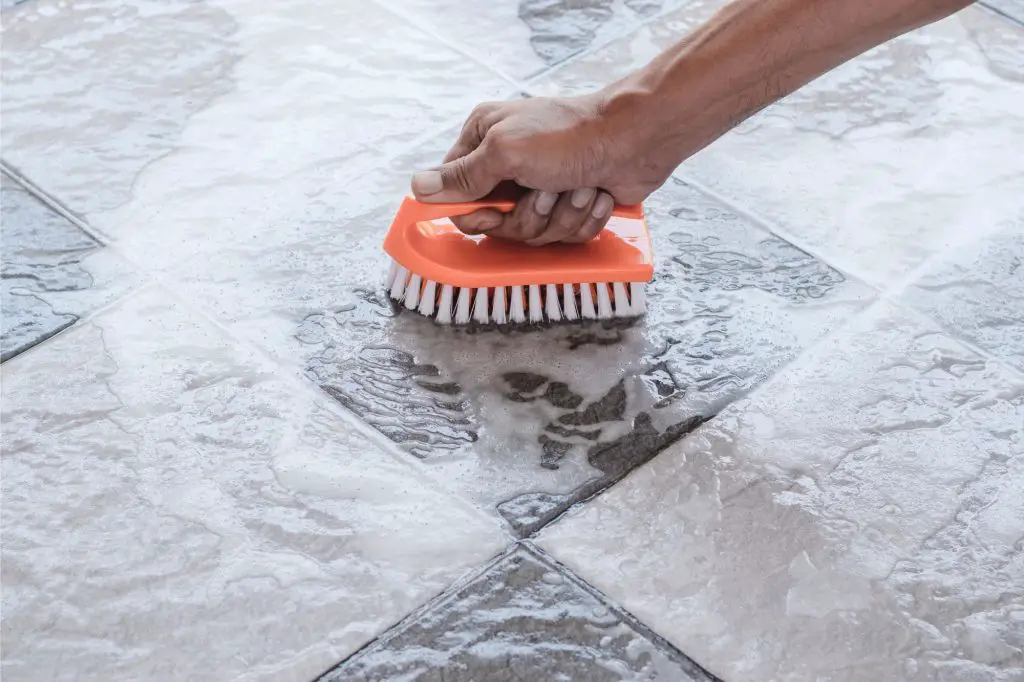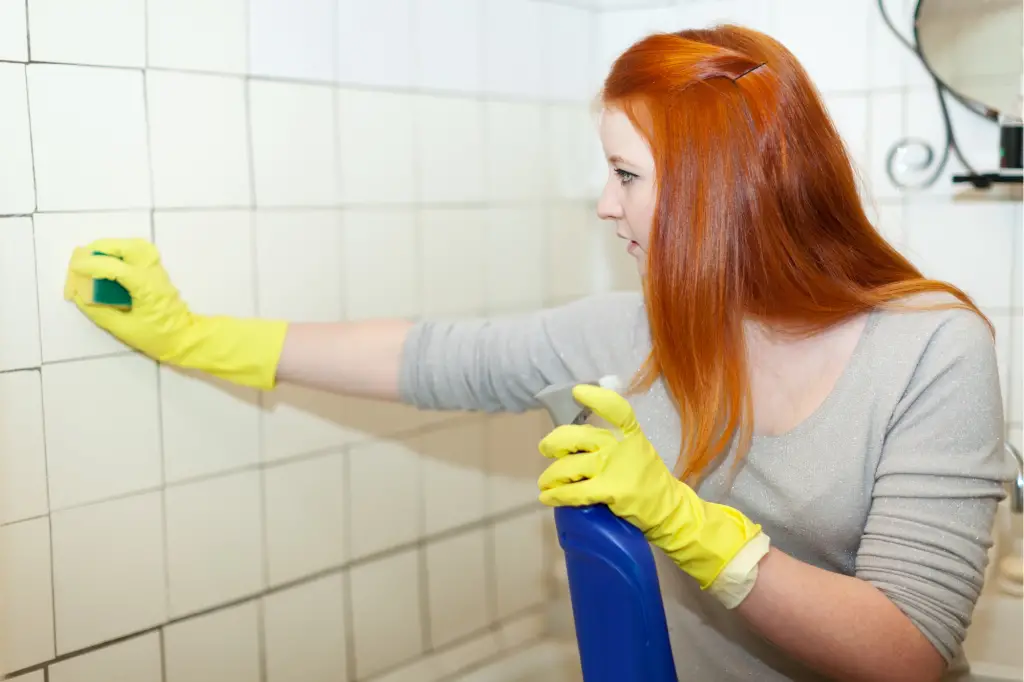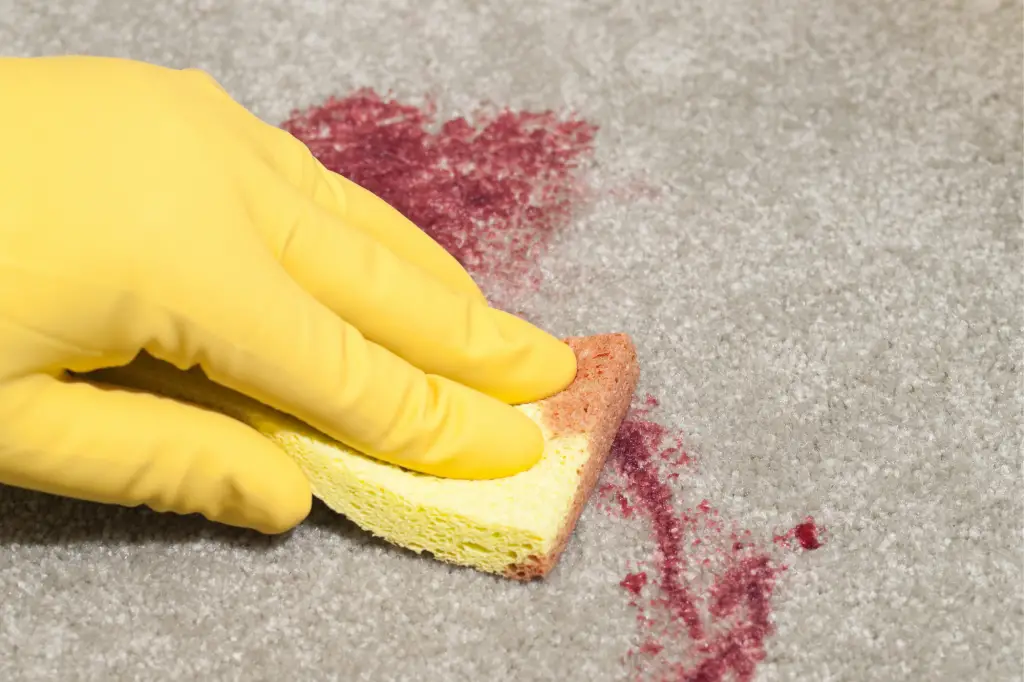Disclosure: This post contains affiliate links and I may earn a small commission if you purchase through these links.
5 Easy and Natural Methods!
One of the most important places to clean is your bathroom, and what better place to start than from the tiles up! Your bathroom tiles see a lot of use with mold, stains, and mildew popping up in every corner and crevice. We’re going to look into some of the most common types of grime and dirt that end up on your tiles, and the easiest ways to clean your bathroom tile stains.
All of your most common bathroom tile stains can be removed using products in your house. Vinegar, lemons, and baking soda are here to solve all your problems. From soap scum to bloodstains, these natural products make short work of stain removal, and we’re going to show you how to use them!
A quick word of advice before we get started: Know your tile! Certain products can harm certain types of tile. It’s important you know exactly what tile you have. Different products have different effects on porcelain and ceramics than on marble or sandstone.
Your Bathroom Tiles
Your bathroom can be one of the hardest places in your house to keep clean. It can be wet, humid, and steamy; the perfect environment for mold and bacteria to grow in. Whenever you spot some of these stains, you should always clean them up immediately.
The longer they stay there the harder they are to remove. These sorts of bacteria can spread quite quickly and do a lot of damage if left alone. Too much mold can even damage your health! So remember that cleaning your bathroom tiles regularly is always worth it.
Getting started cleaning in your bathroom doesn’t require much equipment. A pair of old gloves, an old toothbrush, and a bottle of vinegar with some water will clean almost everything.
So let’s get started with some of the most common bathroom tile stains.
Cleaning the Grout
The best thing to start with when you’re cleaning your bathroom floor is between the tiles. Your grout is a lot messier than it looks, so it’s easier to clean it up first. Cleaning this can make a mess of your actual tiles, but it’ll be worth it to see those clean lines. So start with the worst, and get to cleaning up that grout.

There are a lot of commercial products that give amazing results when dealing with grout. But we’re here to keep it as simple and as healthy as possible for your tiles. So stick with what you have in your home, and crack open that bottle of vinegar.
- All you need is some vinegar and baking soda, and you should be good to go in no time.
- Mix a small amount of vinegar with an equal amount of baking soda until you’ve got a nice white paste.
- Find yourself an old toothbrush or something similar. Apply the solution to the grout. Start scrubbing!
- Rub hard to make sure you get all that dirt out, but don’t use something too wiry or hard to do the rubbing! You don’t want to end up damaging or scratching your tiles.
It won’t matter if your mixture splashes around onto your tiles; it won’t do any harm, and it will even clean them up for you, which is always a bonus.
Once you have your grout covered in the mixture, you’ll need to wait for your vinegar and baking soda mixture to dry. It won’t take long for the mixture to start lifting all the dirt and badness in there.
- After half an hour, give your tiles a quick clean with some hot water, and they’ll be looking a lot better and a lot cleaner.
Using bleach can permanently discolor or stain your grout lines. Similar commercial products can also be dangerous. I would definitely recommend using more natural products.
Vinegar And Water
If you don’t have any baking soda to mix with your vinegar, a simple solution of vinegar and hot water will work too!
- Mix your vinegar and hot water, half and half, together into an empty spray bottle.
- Spray over the affected areas, and leave it on for around 5 minutes.
- Scrub with an old toothbrush to remove the stains, then rinse the area with water to complete the process.
Once you have your grout lines cleaned you can start on the rest of your tiles, but remember to clean up your mess! This way you can admire your handiwork before you move on.
Knowing the difference between ceramic and porcelain tiles, and natural tiles like marble can make cleaning a lot easier, and a lot safer. Here’s a little guide to help out.
Soap Scum
Soap scum can be one of the most annoying and consistent things that occur in a bathroom. The only way to stop it is to ban all soap and water from your bathroom! It is, however, very simple to remove.
For this job, you’ll want to find yourself an old sponge and a pair of gloves.
Like with anything else, vinegar is your answer! To be specific, distilled white vinegar is what you want.
- Mix it with some hot water or baking soda, as we did for the grout before, and apply it to the affected areas.
- Scrub that soap scum away!
- Leave for around 5-10 minutes and then wash clean with some hot water.
The only way to get rid of soap scum is to clean. You should start up a weekly clean, or even a daily clean, depending on how much soap is being used in your bathroom. Commercial products can get rid of soap scum too, but for the simplest solution use vinegar.
Mold
Mold is something that is very easily preventable. Yet if left unchecked, it can cause massive problems for both you and your tiles. Mold can spread to absolutely everything and ruin the finish and style of your bathroom tiles and even your entire bathroom.
Some simple, daily tasks will help you keep the mold at bay and help keep those tiles looking pristine!
- Remember to air out your bathroom every day. Fresh air and sunlight will do your tiles a world of good, and it’s as easy as opening a window for a few hours a day.
- Your bathroom can be a wet and humid place at times, the perfect place for mold and bacteria like it to grow in. A quick bout of fresh air every day will stop this growth in its tracks.
- A quick clean with a mop and some vinegar or a light detergent will help to kill off any mold or bacteria. Remember to get into those corners; mold can spread fast and it’ll only get harder to remove the longer it’s there.
Keeping a regular cleaning schedule will keep your bathroom tiles as clean as they can possibly be. This way you won’t be surprised by an outbreak of mold or mildew.
I did another article on the best shower cleaner for mold and mildew in the shower that some of you may find helpful.
Hard Water Stains
Hard water stains seem to come from nothing. Hopping in and out of the shower, water splashing from the sink, and even just washing your hands can cause these stains.
As always, constant vigilance is required to keep these stains at bay. Make sure you always dry any puddles on the tiles, or you might just wake up to a new and very annoying stain to remove.

Living in a hard water area can be annoying, so if you get tired of cleaning those stains, invest in a water softener. A water softener cuts down on the number of minerals in the water and the number of stains you have to deal with.
If you don’t mind a bit of hands-on work, however, we’ve got the perfect solution.
Lemons!
Lemons are a weak acid, perfect for getting rid of those pesky hard water stains. Lemons leave a wonderful, lemony smell behind them too, so you’re getting clean floors and a fresh smell.
You’ll need around 4-5 lemons (depending on the size or number of stains).
Squeeze them until you get all the juice out, and apply to the affected area. Just make sure you’ve completely covered the area you want.
Simply leave for a few minutes, and wash off with warm water.
Voila! You’ve got shiny, clean floors and a refreshing smell to boot.
Lemons also have a ton of health benefits (for some people) if used correctly in the bathroom. It’s definitely worth looking into if you love the smell and want to use a natural product.
Here’s a nice summary of some of the health benefits of lemons.
Blood Stains
We tend to keep our medical equipment in the bathroom, whether it be bandages or sprays. We’ve also all had an annoying nose bleed or a paper cut, and the first place we all run to is the bathroom sink.
In the race to the sink, drops of blood getting on the floor can often be unavoidable but not unremovable!

Here are some quick and easy tips to remove them.
First of all, you should always wear rubber gloves when dealing with blood, even if it’s yours. If you think it’s hard to get off your bathroom tiles, just wait until you have to try and wash it off your hands!
When working to remove blood from your tiles, be sure about what tile type you’re working with. You don’t want to accidentally damage your floor.
Porcelain or ceramic tile types are less absorbent than natural stones like marble or granite. Natural stones may actually absorb the blood, making everything much harder. As always, be careful, and do your research.
Time is important here. The dryer the blood, the harder it will be to remove.
A quick wash with a mix of vinegar and hot water, 1 part vinegar and 3 parts water, will usually do the trick. You could also try the vinegar and baking soda mixture we referenced earlier.
If natural methods are not working, you may need to move on to trying some commercial products with hydrogen peroxide or some diluted bleach.
If you mix 1/2 a cup of bleach with a gallon of water and apply it to the bloodstain, it should start to fade.
As soon as you see this happening, make sure to rinse the area with hot water and clean it fully.
Always make sure to be extra careful when working with these products. Cleaning up blood can be as dangerous as leaving it on your tiles. This site will help you spot the dangers.
Final Words
I remember when I first moved out to live on my own. I was hopelessly confused by the number of cleaning products that I could choose from, and let’s face it, the work.
Your bathroom tiles see some of the most foot traffic in your entire house, and it’s important to keep them clean. Making your bathroom look pristine and fresh can be a difficult task. Mold, mildew, and countless types of bacteria can grow in the environment that a bathroom creates.
That is why fresh air and sunlight are so important to the hygiene of a bathroom. If there is one tip above all others that I would recommend, it’s that you should always air out your bathroom for a few hours a day.
You’ll see the impact immediately.
Hopefully, some of the tips and tricks in the above article can help make that task easier for you and your family. Thank you for reading.
Further Reading
